Randy Jacobs, M.D. Patient Education
What is dermatology? Your skin is an organ that is expected to be not only healthy, but also lovely and touchable. Think about it, you never hear anyone say, “My, she has an attractive liver.” But, you will hear, “That lady has the most beautiful skin!” This is what true dermatology is all about: Healthy skin that is also lovely to behold, comfortable to live in, and a pleasure to touch. Simply stated, dermatology is the fine medical art of attaining beautiful skin. What is best for you and your own skin problem? It all begins with individualized patient education and clinical guidance.
To read more about dermatology education, scroll down to read about different Dermatology topics.
To provide even more information on Dermatology topics, click here to go to Dermnetnz.org. This is a separate link that provides excellent educational information. (This link will open to a new website not affiliated directly with Randy Jacobs MD.)

| Acne: A Medical Point of Review | ||
 |
Oh no, zits! High school students were interviewed and asked what was most important to their appearance. A thin body, muscles, etc., or clear skin. Clear skin was most important. A recent TV documentary on the biology of human sexuality indicated that... | |
| Acanthosis Nigricans | ||
| Acanthosis nigricans is a disorder that causes light-brown-to-black, velvety, rough areas or increased skin markings usually on the back and sides of the neck. The condition can also at times occur under the arms and in the groin. | ||
| Acne Keloidalis Nuchae | ||
| Acne keloidalis (also spelled "cheloidalis") nuchae is an unusual skin condition affecting the nape of the neck. It commonly affects adult Afro-Caribbean males with curly hair, but it can occur in any individual. The condition may persist for many years. | ||
| Actinic Keratosis 5-FU Therapy | ||
| A message from Dr. Jacobs: The following are photos of Actinic Keratoses of the scalp, lip, ear, and nose. Actinic Keratoses are precancerous, and to prevent skin cancer from developing on your skin, I believe they should be treated. There are many different ways to treat Actinic Keratoses. | ||
| Adult Female Acne | ||
 |
Acne can be one of those conditions about which insensitive jokes are made. Yet psychological research has shown that acne can lower self-esteem and is extremely stressful. One study has shown that unemployment rates are higher in both women and men with acne... | |
| Alopecia Areata | ||
| Alopecia areata (al-oh-PEE-shah air-ee-AH-tah) is a common condition that results in the loss of hair on the scalp and elsewhere. It usually starts with one or more small, round, smooth patches. It occurs in males and females of all ages, but young persons are... | ||
| Apthous Ulcers | ||
 |
Canker sores (aphthous stomatitis) are painful recurrent ulcers or erosions of the mouth which most commonly appear on the lips, gums, inner cheeks, tongue, palate, and throat. They can also occur on the esophagus and genitalia. About 20% of the population has had apthous ulcers. | |
| Atopic Dermatitis | ||
 |
Quite simply, atopic dermatitis is the result of a faulty skin barrier. The skin barrier does not function as normal, and thus, the skin loses vital moisture and also becomes easily penetrated by allergens, toxins, and irritants. | |
| Atypical Mole | ||
 |
Dermatologists often refer to an atypical mole as a “dysplastic nevus.” Dysplastic – Refers to an alteration in size, shape, and cell organization. Nevus (pl. nevi) – Refers to a Mole, and Moles can be atypical, or dysplastic, due to variations in size, shape, or color. |
|
| Bacterial Skin Infections | ||
| One of the functions of healthy skin is to protect your body from bacteria like staph or strep. But a scratch, cut, insect, or pet bite, picking with your fingernails, or even too much hand washing can produce a scrape or break in the skin...leading to a skin infection... | ||
| Basal Cell Carcinoma | ||
 |
Skin cancer is the most common cancer. One in three cancers diagnosed in the U.S.A. this year will be a skin cancer. One in six Americans will develop skin cancer in his or her lifetime... | |
| People of Color | ||
 |
While most skin diseases have the same clinical appearance in Black, White, and Oriental populations, there are some exceptions. Some skin conditions, such as keloids, "flash moles," and ingrown hairs due to shaving, are ... | |
| Cherry Angiomas | ||
| Non-cancerous red or purple growths of blood vessels that mainly grow on the trunk. Cherry Angiomas usually run in families and have virtually no potential to become skin cancer. Classic Cherry Angiomas are harmless... | ||
| Chicken Pox | ||
 |
Chickenpox is usually mild, but it is a highly contagious disease. It is caused by a virus. Exposure to someone who has it will almost always result in the exposed child "catching it". There is no specific medication for killing the virus, so treatment must be directed toward preventing possible complications rather than curing the disease itself. | |
| Chondrodermatitis | ||
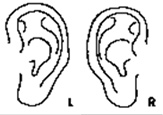 |
Chondrodermatitis nodularis helicis is a painful inflammatory condition affecting the ear. Chondrodermatitis nodularis helicis is inflamed cartilage of the ear with small, intensely painful nodules on the rim or border of the helix of the ear. | |
| Condylomata | ||
 |
Certain types of HPV have been linked with a variety of premalignant and malignant conditions. Genital warts are the greatest cause for concern. | |
| Confluent & Reticulated Papillomatosis | ||
| This 27 year old male patient has a ten-year history of a hyperpigmented, scaly, non-itchy skin condition, which began on his chest and has slowly spread to involve his back, neck, and face.. | ||
| Corns and Calluses | ||
 |
Calluses can be advantageous to some but painful to others, while corns are characteristically painful to all. Gentle paring with a scalpel can differentiate corns and calluses, which may be confused with plantar warts. | |
| Cosmetic Conditions | ||
 |
Patients often ask about removal of benign skin growths or cosmetic type procedures in dermatology. Cosmetic procedures are not covered by Medicare, many private insurances, and HMO's. | |
| Cryosurgery Wound Care | ||
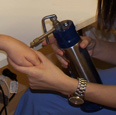 |
Liquid Nitrogen Spray was used today to treat skin growths. The growths may have been benign, malignant, and/or pre-cancerous, depending on your diagnosis. Cryosurgery is an office surgical procedure used to remove growths without cutting the skin... | |
| Darier's Disease | ||
| Darier's Diseases is a slowly progressive inherited disorder of keratinization of the skin. The lesions of this disorder typically appear as small skin-colored bumps about the size of a pinhead or pea. | ||
| Dermatofibroma | ||
| A dermatofibroma is a common benign fibrous skin lesion. A dermatofibroma is also sometimes called a histiocytoma. Dermatofibromas are dome-shaped, are pigmented (or have a ring of pigment), and usually (but not always) ... | ||
| Diabetic Foot Care | ||
| The average human walks 70,000 miles in a lifetime! The feet work so hard for us, but are often the most forgotten parts of our body. In particular, diabetic feet need extra special care. Chronic wounds and infections of the skin, particularly of the feet, are more common in people with diabetes than in non diabetics. | ||
| Diabetic Skin | ||
| Diabetes is an endocrine (hormonal) disease in which the body loses the ability to maintain normal levels of sugar in the blood. There are two kinds of diabetes... | ||
| Diaper Dermatitis | ||
 |
Diaper rash usually occurs in two stages: First there is irritation of the skin in the diaper area caused from a combination of the moisture under the diaper from the skin, the urine, and the stool. | |
| Discoid Lupus | ||
| DLE is one of a large number of conditions occurring in a rare disease called systemic lupus erythematosus (SLE). Only a few people with DLE also have SLE. | ||
| Drug Rash | ||
| Dermatitis Medicamentosa is a term used to describe any of the group of those skin eruptions or changes which may occur as a result of the ingestion or parenteral administration, or contact with, virtually any drug. | ||
| Dry Skin & Skin Barrier Education | ||
| Quite simply, dry skin is skin that has lost its moisture. This loss of moisture is, most commonly, the result of inadequate daily moisturization in personal skin care habits, plus, the overuse of strong soaps, plus, exposure to dry air. All of these factors ead to a damaged skin barrier. | ||
| Eczema | ||
 |
A famous Austrian doctor named Hebra described it well years ago when he said, "Eczema is what looks like eczema." Sound confusing? It's not really. What Hebra meant was that eczema is not defined by what causes, it, but by what it looks like. | |
| Erosive Pustular Dermatosis of the Scalp | ||
 |
The cause of erosive pustular dermatosis of the scalp is unknown. However, it appears to relate to sun damage and is possibly triggered by a minor injury to the affected skin (including a surgical procedure). Infection is not thought to be the primary cause, as the lesions do not clear with antibiotics alone. | |
| Erythema Multiforme | ||
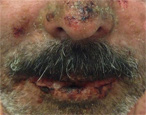 |
Erythema multiforme is the name given to a short-lasting illness, which sometimes recurs. It causes a rash and often blisters in the mouth and elsewhere. There are three subtypes... | |
| Erythema Nodosum | ||
 |
Erythema nodosum is a skin condition where red lumps form on the shins, and less commonly the thighs and forearms. Erythema nodosum of unknown origin. Three to six women are affected for each man with erythema nodosum (EN). | |
| Exanthems - Fifth Disease | ||
 |
Exanthems are a common cause of generalized rashes in children. They pose a diagnostic challenge to even the most experienced physician because of the diversity of their clinical presentations. | |
| Examthems - Measles | ||
 |
Measles is caused by paramyxovirus RNA virus. The spherical virus particles are approximately 100-200 nm in diameter. Measles virus is highly labile which results in a very short survival time when it is not associated with a host. | |
| Exanthems - Roseola | ||
 |
Sixth Disease, also known as "roseola infantum" is an acute infectious disorder of infants or very young children. Characterized by high fever and the appearance of a red skin rash, this disorder may resemble rubella after the fever has disappeared. Seizures may also occur. | |
| Exanthems - Rubella | ||
 |
Rubella is also known as German Measles or Three-Day Measles. Rubella is a contagious viral disease characterized by swelling of Iymph glands and a rash. A pregnant woman infected with rubella during the early months of pregnancy may develop an abortion, stillbirth or ... | |
| Exfoliative Dermatitis | ||
| xfoliative dermatitis, also known as exfoliative erythroderma, begins as a rapidly developing, generalized redness of the skin surface. Fine scales or thick sheets of desquamation follow the erythrodermic stage. Pruritus (itching) may be severe. Hair loss and nail abnormalities may accompany... | ||
| Eyelid Eczema | ||
| Eyelid Dermatitis: Itchy eyelids are usually due to an allergic or irritating substance that touches the eye area. So, eye areas need extra avoidance of allergic agents. Remember, the eyelid skin is very thin and is highly susceptible to allergens and irritants. | ||
| Fragile Skin Bruising | ||
| Easy bruising and bleeding into the skin of the tops of the hands and forearms occurs in many middle-aged and older people, especially if their skin is fair. This easy bleeding which can occur without apparent injury is a result of the skin's being made thin and fragile by years of sunlight exposure. | ||
| Granulation Tissue | ||
| Granulation tissue is the pink layer you find under a scab if you pick it off. Proud flesh is also known as persistent granulation tissue, and occurs when the scabs normal granulation tissue does not go away. Proud flesh can persist for years until it is removed, destroyed, ... | ||
| Granuloma Annulare | ||
| Granuloma annulare is a benign, self-limited disorder affecting the dermis or lower parts of the skin. Granuloma annulare is characterized by cutaneous non-scaled papules often arranged in an annular or ring-like configuration. For this reason, the condition may be mistaken for ring worm. | ||
| Grover's Disease | ||
| Grover's disease is an itchy skin condition on the chest and back. Grover's disease most often affects men over 50. It is also known as "transient acantholytic dermatosis", and is much less common in women or younger people. Grover's disease often starts quite suddenly. | ||
| Hair Loss | ||
 |
Alopecia is the medical word for hair loss. Healthy hair grows in a cycle, and, it is normal to lose hair and grow it back during this cycle. You lose, you grow, you lose, you grow... | |
| Herpes Simplex | ||
| Herpes simplex is a virus infection. It occurs occasionally in some people and again and again in others. It produces what is commonly known as a fever blister. Herpes virus has the peculiar ability to go into a latent stage, lying dormant in the body. It appears that this virus stays with us for life. | ||
| Hidradentis | ||
| This long medical term refers to painful, red, tender lumps which may also become secondarily infected and appear under the arm and in the groin. The glands involved in this disease are the apocrine (sweat) glands. | ||
| Hyperhidrosis | ||
 |
Sweating is a natural body function needed for the regulation of body-temperature. There are five million sweat glands throughout the body and about 2/3 of these gland are located in the hands. The secretion of sweat is controlled by the sympathetic or (vegetative) nervous system. | |
| Impetigo | ||
 |
The most common cause of blistering sores in children is called impetigo, an infection often passed on in crowded or unsanitary environments. The sores are small, no larger than 1 to 2 millimeters across, and often appear in groups on the child's face, arms or legs. | |
| Ingrowing Nail | ||
 |
Unguis Incarnatum--otherwise commonly known as an "ingrowing nail" is a relatively common condition in which the nail (most frequently that of the great toe) pierces the lateral nailfold and enters the dermis of the skin, where it initiates a foreign body reaction and possible infection. | |
| Intertrigo | ||
| Intertrigo is type of inflammation of the top layers of skin caused by moisture and bacteria in skin fold areas. This is common in overweight people and is usually located in the inner thighs, armpits, and undersides of the breasts. Most cases develop in hot moist environments and in summer months. | ||
| Keratosis Pilaris | ||
| Keratosis pilaris is a common condition of children and young adults in which tiny follicular papules form. Keratosis pilaris consists of small clustered, firm, white papules approximately one millimeter in diameter. | ||
| Leukoplakia | ||
 |
Leukoplakia may be defined as an abnormal hyperplastic (increase in the number of normal cells) response of mucous membranes with excessive keratinization. Simply speaking, it is a whitish thickening of the tissues that line such areas as the mouth, anus, or vagina. | |
| Lice Head and Pubic | ||
| The head louse is one variety of a number of different lice. This type has chosen to make your scalp, and the hair on it, its home. | ||
| Lichen planus is a relatively common inflammatory, pruritic (itchy) disease of the skin and mucous membranes. Lichen planus is characterized by distinctive papules which may be as small as a pinhead or larger. | ||
| Lichen Sclerosus is a relatively uncommon inflammatory, dry, pruritic (itchy) disease of the skin and mucous membranes. Lichen Sclerosus is characterized by distinctive papules which may be as small as a pinhead or larger. | ||
 |
So many patients ask, “What is Lupus?” Really, lupus is a very complicated diseaes, so, for educational purposes, I am giving you this written information. Lupus is a chronic, autoimmune disease which causes inflammation of various parts of the body... | |
| There has been a sharp increase in awareness of skin cancer in recent years as the result of a worldwide campaign against this disease and reports about the thinning atmospheric ozone layer, which is allowing greater penetration of harmful ultraviolet rays. Skin cancer is the most common cancer. | ||
| Melasma appears as a blotchy, brownish pigmentation on the face that develops slowly and fades with time. Melasma usually affects women but occasionally is seen in young men who use after-shave lotions, scented soaps, and other toiletries. | ||
| Molluscum contagiosum consists of small, harmless skin growths caused by a virus. They resemble pimples at first. They are often confused with warts. | ||
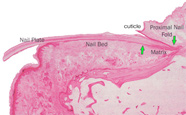 |
Nails often reflect our general state of health. Changes in the nail, such as discolocation or thickening, can signal health problems including liver and kidney diseases, heart and lung conditions, anemia and diabetes. | |
 |
Simply, patients with nostalgia paresthetica experience a frustratingly resistant itch on their back. The dermatologist may not find anything unusual on the surface of the skin, except for a slight increase in pigmentation, but the patient is bothered by continuous itch. | |
| Papular urticaria is a skin reaction to flea bites and is a result of an immunologically mediated reaction. It usually manifests as an intensely pruritic ( itchy ) lesion at the bite site. It is most common in children although any body can develop these lesions.
|
||
| Paronychia is an inflammatory reaction involving the folds of skin surrounding the fingernail. Paronychia may be acute or chronic, purulent, tender, and painful with swelling of tissues around the nail. | ||
| Bullous pemphigoid is a blistering skin disease which usually affects middle aged or elderly persons. Symptoms: Bullae (large blisters, thin walled sacs filled with clear fluid, greater than 1 cm. diameter) multiple usually located on the arms, legs, or ... | ||
| Pemphigus is an autoimmune skin disorder characterized by blistering of both the skin and mucous membranes. Pemphigus is defined as a group of chronic blistering diseases in which histologically there is acantholysis and blister formation within the epidermis. | ||
| Perioral dermatitis has been defined as a persistent erythematous (reddish color) eruption of the skin composed of tiny papules and little papulopustules, distributed primarily around the mouth. Perioral dermatitis is a fairly recent dermatologic diagnosis. | ||
| Pityriasis alba is a common mild dermatitis inflammation of round or oval slightly scaly patches which leave pale hypopigmented marks after the inflammation has faded. | ||
| Pityriasis rosea (pit-ih-RYE-ah-sis Ro-ZEA) can occur at any age but it's more common in people between the ages of 10 and 35 years. It appears as a rash which can last from several weeks to several months. | ||
 |
Pityriasis rubra pilaris (pit-ih-RYE-ah-sis) is a chronic skin disorder with reddish orange colored scales and papules in a hair follicle distribution. Pityriasis rubra pilaris can occur at any age but it's more common in people between the ages of 10 and 50 years. | |
| Pityriasis Lichenoides can occur in two forms: acute and chronic, but there is an overlap between them. The acute form is called: PLEVA which is Pityriasis Lichenoides et Varioliformis Acuta also known as Mucha-Habermann's disease. | ||
| Poison Plants: Ivy--Sumac--Oak. Also known as poison ivy in the East, poison oak in the West and poison sumac and ivy in the South -- grow practically everywhere in the United States, except Hawaii, Alaska and some desert areas of Nevada. | ||
| Porokeratosis is a chronic progressive skin condition in which there are multiple abnormal skin patches with dry, atrophic center and elevated warty border in circumscription of each lesion, like a collar... | ||
| DSAP is an unusual inherited skin condition causing dry patches on the arms and legs. DSAP is a special type of inherited "sun spot", different from ordinary sunspots (called solar keratoses). | ||
 |
Pressure sores are caused by continuous pressure that prevents blood flow to the skin, and thus, prevents oxygen from getting to the skin. The result is death of the skin due to lack of oxygen. This “skin death” is the pressure sore. | |
 |
Skin Facts: Itching of the skin around the anus (opening towards the rectum) is a common complaint. This area of sensitive skin is exposed to irritating digestive products in the stool. | |
| Pseudofolliculitis barbae is the response of the skin to an ingrown hair. It is a foreign body response. Pseudofolliculitis barbae is one of the most common skin complaints of black men, occurring in 45 to 80 percent of those men who shave. | ||
 |
Psoriasis is a common, recurring skin condition in which the skin develops reddish silvery plaques and scales. Psoriasis most often affects the scalp, trunk, and outer sides of the arms and legs. Itching is common. | |
| Many disorders of the skin are very difficult to diagnose with certainty, and may often have multiple causes. Sometimes there is a psychological factor involved as either the principle or contributing cause of the problem. | ||
| This is a condition in which the smallest arteries that bring blood to the fingers or toes constrict (go into spasm) when exposed to cold or from an emotional upset. Smoking cigarettes or working with vibrating machinery also can cause these episodes. | ||
 |
Photoaging is a common sun induced problem in Southern California. The signs of photoaging are thin, wrinkled, discolored, leathery skin, as well as precancerous and cancerous growths. | |
| Ringworm is a fungal (dermatophyte) infection of the skin, hair, or nails. It gets its name from its appearance on the skin. There are two main varieties of fungi causing dermatophyte infections: Trichophyton and Microsporum. | ||
| Rosacea, pronounced "rose-ay-sha", is a dermatologic disease that causes redness, pustules, papules, and inflammation of the facial skin. Rosacea is commonly, but mistakenly attributed to alcohol consumption or may be referred to as "adult acne” as it is related to acne. | ||
| More than a century after its initial description, sarcoidosis remains a biological and clinical enigma. An etiologic source has yet to be identified, diagnostic tests are largely non-specific and therapy, limited for the most part to severe cases, produces inconsistent results and often fails to halt disease progression. | ||
| Scabies also known, as "mites" is an intensely itchy rash caused by a tiny mite that burrows in the skin. The mite is only 1/60 inch long, and is almost impossible to see. The rash usually involves the hands, wrists, breasts, genital area and waistline. | ||
| Schamberg's disease is a condition in which there is multifocal extravasation (leakage) of blood in a distinctive pinhead pattern on the skin of the lower or upper extremities (legs and sometimes arms) | ||
| Localized scleroderma is a chronic disease of unknown cause with no known cure. Women are affected three to four times as often as men. Unlike systemic scleroderma, it is uncommon to find involvement of the internal organs. | ||
 |
Your itchy face and scalp may be due to seborrheic dermatitis. The name may make you wonder if it is a rare disease. Far from it, Seborrheic dermatitis AKA "seborrhea" is one of the five most common skin conditions, and can affect all ages. | |
| Seborrheic keratoses (SK's) are harmless, common skin growths that first appear during adult life. As time goes by, more growths appear in older years. Some persons have a very large number of them. | ||
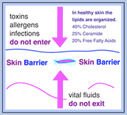 |
Dry Skin Anatomy & Physiology: What is The Human Skin Barrier? | |
| One of the functions of healthy skin is to protect your body from bacteria like staph or strep. But a scratch, cut, insect, or pet bite, picking with your fingernails, or even too much hand washing can produce a scrape or break in the skin. | ||
| A Skin Tag is also known as an achrocordon. These lesions are small benign growths, they tend to form in areas where the skin forms creases, such as the neck, armpit, and groin. They can also grow on the face, and the eyelids. | ||
| Many different kinds of spiders live around homes and buildings. The vast majority are harmless, and in fact are beneficial, because they prey upon flies, crickets and other insects. | ||
 |
Squamous Cell Carcinoma: The Second Most Common Cancer in Man. Skin cancer is the most common cancer. One in three cancers diagnosed in the U.S.A. this year will be a skin cancer. One in six Americans will develop skin cancer in his or her lifetime. | |
 |
Stasis Dermatitis is a chronic rash stemming from poor circulation (low oxygen) of the legs due to internal varicose veins or poor circulation for other reasons. This includes poor heart function and any type of blockage to the circulation. | |
| Striae distensae is the fancy name for stretch marks. Stretch marks (striae distensae) are an unsightly cosmetic problem that plague many women and some men. | ||
 |
Many people do not realize that rays of the sun can actually penetrate to certain skin levels inside the body. Thus, sun rays can alter the DNA of your skin cells and can cause damage. | |
 |
Too much sunlight can be dangerous. Being outside on a warm, sunny day is one of life's great pleasures, but getting too much sun can be dangerous. Excessive sun exposure can result in painful sunburn, but can also lead to... | |
 |
Sweet's Syndrome (Acute Febrile Neutrophilic Dermatosis) has been first described by the English dermatologist Robert Douglas Sweet from Plymouth in 1964 following the observation of 8 female patients. | |
 |
The syringoma, a benign sweat duct tumor, belongs to the classification of skin neoplasms known as the "skin appendage tumors"--thus called because they display certain structural similarities to the hair follicle, the sebaceous gland, the epidermis, the apocrine gland, or the eccrine gland. | |
 |
Over time, the sun invisibly penetrates your skin, burns, and causes damage to your microscopic skin cells. The fibroblast cells (the cells that produce collagen and elastic skin tissue) are damaged. This causes collagen damage and elastic tissue damage and results in wrinkles. | |
 |
Athlete's foot is a very common skin condition--many people will develop it at least once in their lives. It is usually found between the toes, but sometimes affects the soles of the feet. The nails are usually involved. It consists of cutaneous lesions caused by Dermatophytes, a kind of skin fungi. | |
 |
Tinea Versicolor is caused by Malassezia furfur which is the mycelial phase of Pityrosporum orbiculare, a yeast which is a component of normal skin flora. It is slightly contagious but the disease is usually autogenous. | |
| Hives are an allergic response of the skin causing crops of raised, red, itching areas, which may come and go. The crops may last for a few minutes or hours, may disappear, and may break out in another location. | ||
| Vasculitis (pronounced vaa-skew-lite-iss) is inflammation of the blood vessels. Inflammation is a condition in which tissue is damaged by blood cells which enter it. These are mostly white blood cells which circulate and are our major defense against infection. | ||
 |
Vitiligo is an auto immune condition which results in depigmentation: various sized, white, sharply demarcated macules and patches of the skin. In vitiligo, the patient's own immune system is responsible for "attacking" the skin's own pigment cells. | |
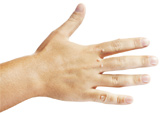 |
Warts are common growths on the skin caused by a virus. Warts may grow on any part of the skin. For example, warts on the feet are called plantar warts. It takes one to six months to develop warts after exposure to the wart virus. | |
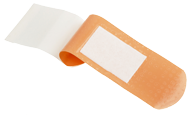 |
Wound Care Instructions After Biopsy or Skin Procedures Follow these instructions for best healing. Your most important goal: Prevent infection. | |

